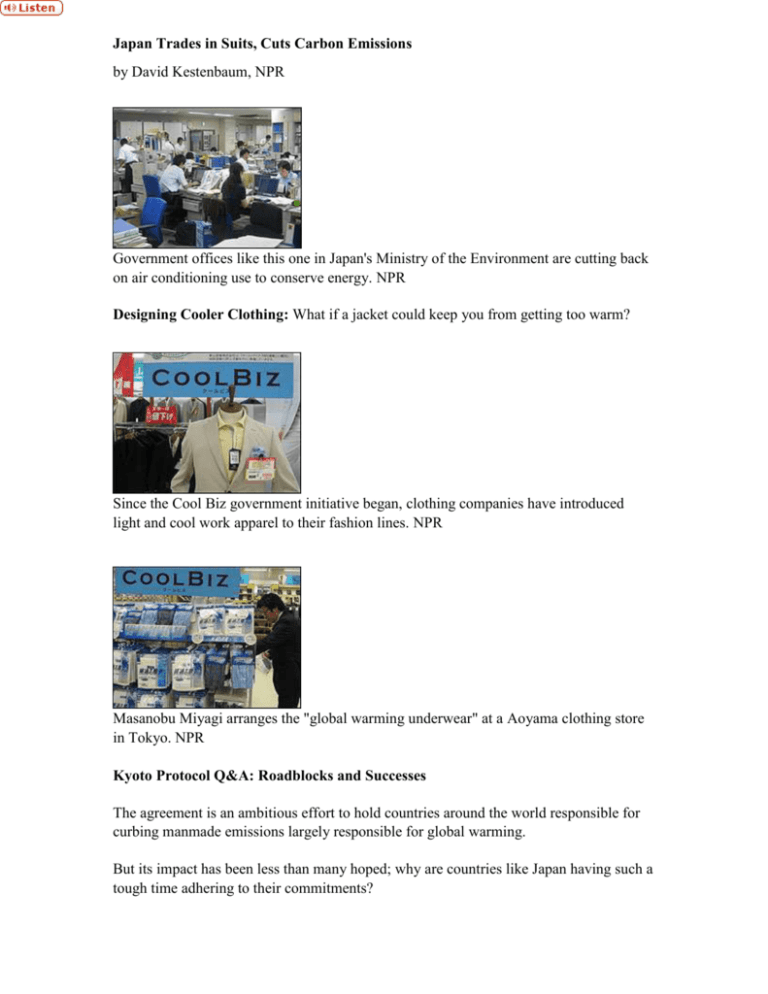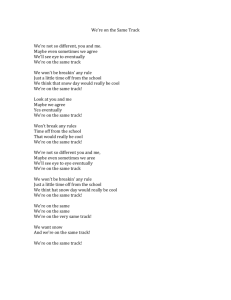Japan Trades in Suits, Cuts Carbon Emissions
advertisement

Japan Trades in Suits, Cuts Carbon Emissions by David Kestenbaum, NPR Government offices like this one in Japan's Ministry of the Environment are cutting back on air conditioning use to conserve energy. NPR Designing Cooler Clothing: What if a jacket could keep you from getting too warm? Since the Cool Biz government initiative began, clothing companies have introduced light and cool work apparel to their fashion lines. NPR Masanobu Miyagi arranges the "global warming underwear" at a Aoyama clothing store in Tokyo. NPR Kyoto Protocol Q&A: Roadblocks and Successes The agreement is an ambitious effort to hold countries around the world responsible for curbing manmade emissions largely responsible for global warming. But its impact has been less than many hoped; why are countries like Japan having such a tough time adhering to their commitments? Morning Edition, October 2, 2007 · Two years ago, the Japanese government — essentially with the stroke of a pen — instituted a new policy that has so far trimmed more than two million tons of greenhouse gases from the country's growing emissions. The feat is particularly impressive because it required overturning a decades-old tradition. When Yuriko Koike was Japan's environment minister, one of her jobs was to figure out how to deal with climate change. So she hit on what — in Japan — was a radical idea: Get men to stop wearing suits. That way, office buildings could ease up on the air conditioning. A Radical Proposal Showing up with no tie and no jacket was seen as rude in many circles. But Koike had the support of the charismatic prime minister, Junichiro Koizumi. Koike's Cool Biz initiative launched June 1, 2005. The top government officials — the heads of the ministries — came to work without jackets and ties. Koike, as it turns out, was out of town. "I was in Paris on that particular day, and I saw the satellite news program in my hotel in Paris," she recalls. "And I was shocked. I tried to shock people. But I was shocked." The prime minister looked good. Others … not so much. "Somebody looked very loose or rude or funny," Kioke says. "It created a real shock!" The tie-makers complained. And what about the men who weren't good at fashion? Would they panic? The suit and tie were safe and reliable. The Environment Ministry published a help sheet with suggestions of how to dress during the summer. Koike came up with the idea of stickers that said, in essence, "Excuse my attire, I'm doing Cool Biz." A Cool Transition And it worked. Air conditioners were turned up to higher temperatures in all government buildings, saving electricity. As a result, half a million tons of CO2 that would have normally been released into the atmosphere, was not. And the second year — 2006 — Koike says the number of companies and numbers of businessmen who participated in the Cool Biz initiative expanded enormously. The participation numbers doubled or tripled, cutting about 1.4 million tons of CO2 emissions. "That is equivalent to half of the Tokyo area's CO2 emissions of a month," Kioke says. But the most surprising part of this is that the suggested temperature for air conditioners as part of the campaign was 28 degrees Celsius, or about 82 degrees Fahrenheit — that's seven degrees warmer than what you might find in a typical U.S. office building. And for government buildings in Japan, the 82-degree setting is mandatory. On a visit this summer to the Environment Ministry, the building was warm and humid — workers have that shiny, post-perspiration look. But they also said it wasn't so bad. They got used to the heat and they felt good about doing something to help address climate change — except when it occasionally got hotter. On one floor, the area next to the elevators recorded at 31.2 degrees Celsius, or 88 degree Fahrenheit. Temperatures were high in some offices, too. Masashi Komurasaki carried around a small cloth to mop his brow. "There are lots of printers and PCs and lots of machines," Komurasaki says. "Because of that, it's very, very hot and humid. Also after 8 p.m., air conditioners totally stop, so it's a kind of hell." It's kind of hell? "It's a kind of hell," Komurasaki laughs. "Not kind of — it's hell!" Gaining Ground You wonder how something like this would go over in the United States. When President Carter got on television in the 1970s and urged people to conserve by wearing a sweater in winter, people laughed. It's tempting to chalk Japan's success up to cultural differences and a greater willingness to make individual sacrifice for a larger good. But Japan had its own Carter moment. A prime minister once tried to push the idea of men's suits that had short sleeves. People thought it looked ridiculous. Cool Biz was a well-executed plan: It was propagated by peer pressure and common sense. Why wear a suit and tie in the summer? Some women cheered the end of arctic office temperatures. Japan's powerful business association, Keidanren, which represents about 1,300 major companies, says 70 percent of its companies now keep the air conditioners set to 28 degrees Celsius, or 82 degrees Fahrenheit. Retailers React And some retailers see Cool Biz as a chance to make money. The barber's association in Japan is promoting a Cool Biz hair cut, styled in the shape of a Mohawk. There's also a new market for Cool Biz clothes. The Aoyama clothing store in Tokyo's Ikebukuro neighborhood advertises global warming suits for men. Store manager Masanobu Miyagi says the best suit to have to stay cool is the "Su su suit" — or the one-pound suit, so light you barely know you're wearing it. The company has sold 400,000 Cool Biz suits, which cost about $500 each. The store also carries global warming underwear. "Once you wear these, you won't wear others boxers," Miyagi says. But something is a little funny. The store is suspiciously cool. "I think this place is set a bit cooler than 28 degrees (82 degrees Fahrenheit)," Miyagi explains. "Well, I think if it's hotter, the people cannot concentrate on choosing the suits. Here is a place for them to choose their uniform to work. Better to set a little cooler." Lingering Obstacles And the truth is that cutting back on air conditioning alone is not going to stop climate change. Koike, the former environment minister, says she intended Cool Biz to be a wake-up call. Japan has pledged under the Kyoto Protocol to reduce its greenhouse gas emissions to 6 percent below 1990 levels. Instead, emissions have grown 8 percent. The Cool Biz savings amount to 0.1 percent. by Erin Marie Williams, NPR An inflated jacket with arrows illustrating how the fans direct air-flow through the clothing. Meadownics Inc. The complete kuchofuku package: a jacket, two fans, and a battery pack. Meadownics Inc. NPR.org, October 1, 2007 · Imagine being able to create a personal temperaturebubble – being able to decide whether it's warm or cold at any given time. A company in Japan is attempting to make this a reality. Meadownics, a self-proclaimed eco-friendly producer of green products, is making "air-conditioned" shirts, jackets, and pants that will allow people to cool off wherever they go. But at this point, the styles are limited and the costs high, which could hinder quick adoption. Your Own Personal Air Conditioner The concept of kuchofuku, or air-conditioned clothing, is to start with the cooling system each of us was born with — and help it along a little bit. Everyone sweats when their muscles overheat, and this sweat cools the body as it evaporates. Up to a point, this natural system works pretty well. But the hotter someone gets, the more they sweat — and only so much of that sweat can evaporate at a time. After awhile, it starts to build up — and then begins beading on the skin. Soon enough, clothes end up absorbing the dampness and it becomes hard to appear cool and sweat-free. With its products, Meadownics aims to help the evaporation along — speeding it up a bit says Meadownics spokesperson Sumiko Imagaw. The company's clothes are not air-conditioned in the sense that many of us are used to; they haven't shrunk down window-units and stitched them into shirts and pants. But they've done something close. The clothes are equipped with two small fans, about 10 centimeters across, that pull air in and pass it up against the body. This additional air-flow directly against the skin increases the rate of evaporation. A small dial can be cranked up to increase air-flow and evaporation, based on the heat level. While it's not quite like living in a sci-fi movie, the small fans — sewn into the sides of polyester, or cotton, jackets and shirts – are visible for the world to see. The dial is hidden away on the inside of the clothes. Saving Money? Meadownics is marketing kuchofuku as a cost-effective alternative to traditional air-conditioning. But the clothes are not cheap. Shirts cost $107, jackets run from $117 to $164, and pants are about $127. An energy bill would need to equal more than $1,638 for the months of June through September, which is the cost of seven shirts and pants sets, to be a money-saving option. Meadownics suggests that a factory of 1,000 square meters with 50 employees can save hundreds of thousands of dollars in both initial startup costs and monthly electricity bills by outfitting employees in air-conditioned clothes rather than relying on traditional central air. This may explain why they have marketed primarily to large companies in Japan thus far. Although the company is expanding, their clothes are not yet available in U.S. stores. A New Source of Energy? In line with the company's eco-friendly pitch, Imagaw points out that kuchofuku clothes run on rechargeable lithium ion batteries, or AA rechargeable nickelhydride batteries, not the mercury-filled batteries of yore. And because they are rechargeable, they have to be replaced less often; with the fan set to high, the batteries will last about five hours. Although some rechargeable batteries do contain harmful heavy metals, like cadmium, the metals in nickel-hydride and lithium ion are considered nontoxic. There is also a battery alternative for people with desk jobs: USB power cords to plug into your computer. So far, Meadownics stands alone in the air-conditioned clothing market. Although companies worldwide are developing lightweight, cooler clothing lines, Meadownics is the only one to actually put "air-conditioning" units into their clothes. And they're not stopping at clothes. According to their Web site, bed pads and chair cushions will also soon be available. And for winter wear, the company has developed battery-powered heated gloves.







